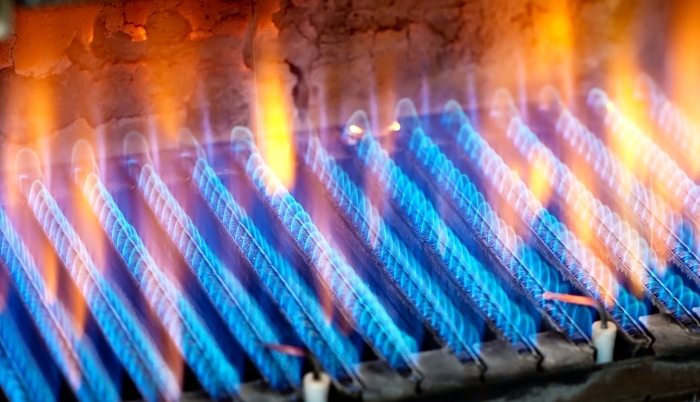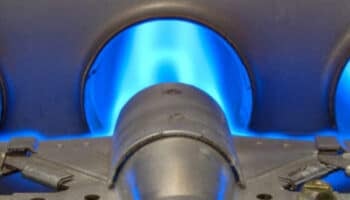Is there a yellow pilot light on your furnace, and you’re trying to figure out why?
You’re not alone! In fact, thousands of homeowners all over the world face the same issue daily and are left confused and worried about the situation posing a danger to them or their families.
I know it can be very annoying and concerning to have your pilot light look yellow instead of the usual blue you’re used to. But don’t worry; you’ve come to the right place for answers. Below, you’ll find a list including 6 of the main causes behind a yellow pilot light and simple ways to address them.
When there’s a yellow pilot light on your furnace, it can be due to dirty burners, improper combustion, contaminated gas, or insufficient oxygen. Low gas pressure and high carbon monoxide levels can also be to blame.
Read on to get your pilot light back to its normal color!
Why There’s a Yellow Pilot Light on Your Furnace
Furnace pilot lights are meant to burn at specific temperatures and under very specific conditions. When one or more of the necessary conditions aren’t met, the light of the flame can change drastically and cause a wide variety of issues.
To help you get to the bottom of the issue quickly, here are some of the things that, in my experience, should be checked first when you find yourself in such a situation.
#1 Dirty Burners
The first thing that can cause a yellow pilot light on a furnace is dirty or clogged burners. Your furnace’s burners need clean and unobstructed burners to burn at the right temperature, as well as get enough oxygen and gas.
If you fail to clean your furnace’s burners often, the flame coming from them will flicker, turn yellow, or not ignite at all. Burner blockage can happen over time due to soot buildup and other debris.

Solution: I find that the simplest way to address the issue is by cutting off the gas supply and power to the furnace and waiting until it cools down completely. Then, get clear access to the burners and use a wire brush to remove any impurities. If you want to go the extra mile and disinfect the area, you can use a mixture of equal parts water and vinegar.
Once you’re certain you’ve cleaned the burners thoroughly, restore gas and power to the furnace and see if the pilot light is still yellow. If so, please read on for more potential solutions.
#2 Improper Combustion
The next possible reason why you’re dealing with a yellow pilot light on your furnace is that the gas entering the burners is not burning properly. Improper combustion can happen for many reasons, including a blocked gas line, low-quality gas, reduced airflow, and more.
Many issues can arise from improper combustion, such as excess soot buildup in and around your furnace, bad thermocouple readings, and even excess carbon monoxide entering your home.
Solution: The first thing I recommend you check when you suspect there’s improper combustion happening inside the furnace is the gas line and the gas supply valve. See if the line is blocked in any way.
It’s also possible that a blocked chimney can prevent gas residue from leaving the furnace, forcing the partially burned gas back into the appliance and its burners. While furnaces don’t typically burn 100% of the gas they draw if your appliance is being inefficient enough to show a yellow pilot flame, it’s cause for concern, and you should call a technician as soon as possible.
#3 Contaminated Gas
The next possible reason why there’s a yellow pilot light on your furnace is a contaminated gas supply. In order to work normally, your furnace needs high-quality gas to burn and provide the heat you’re used to. However, I’ve found that the flame can burn yellow when the gas going into your furnace is subpar or has been contaminated somewhere along the production process.
Gas contamination can come from a problem during production, improper storage, or any other event in the supply chain that has gone unnoticed.

Solution: In my experience, there’s no way to tell for sure whether the reason why your pilot flame is yellow is contaminated gas without a process known as gas chromatography and someone who knows how to interpret the test results.
On paper, you should also be able to see residue in your gas supply indicating bad-quality gas; however, it’s not always apparent, and the lack of it can trick you into thinking your gas is okay.
#4 Insufficient Oxygen
Now, let’s discuss oxygen and its importance when it comes to getting a nice, blue, steady flame from your furnace. As you may know, in order for there to be fire, there must be a combustible and a comburent. In this case, the combustible is gas, and the comburent is oxygen.
Your furnace’s burners are designed to let a certain amount of oxygen through to ensure the flames inside it are always steady and bright blue; however, if the burners are obstructed, or there’s not enough airflow into the appliance, you’ll likely run into problems.
Solution: What I’d recommend you try first is to check whether there’s too much clutter around your furnace that could be preventing proper airflow. If so, you can try to clear space around the furnace and see if that makes oxygen flow better. In the event that removing clutter around the furnace doesn’t work, and you’ve already cleaned the burners, you’ll have to try more potential fixes below.
#5 Low Gas Pressure
From what I’ve seen over the years, low gas pressure can also play a significant role in determining whether your furnace’s flame will burn steady and blue or unstable and yellow.
Gas must flow at a preset pressure level to ensure it combines with the oxygen in the air. When oxygen is low and the gas pressure is normal, you’ll likely get a yellow pilot flame, and the same will happen when oxygen is flowing normally, but your gas pressure is affected in any way.
In my experience, there can be many possible reasons to explain why you currently have low gas pressure – from an obstructed gas line to a faulty gas valve and even a bigger issue with your home’s gas supply.
Solution: The first thing you must check when you suspect low gas pressure going into your furnace is the gas line. The gas line is what connects your home’s gas supply valve to the furnace’s inlet. Depending on your furnace’s brand and model, the gas line will be located in different sections of the appliance, so I recommend you check your User Manual for an accurate layout of your unit.
If you no longer have the manual handy, please refer to our free resource below.
Once you know where the gas line is, please cut off power and gas to your furnace by turning off the gas valve on the wall and flipping your circuit breakers. Also, please wait for the furnace to be completely cool.
When the ideal conditions are met, locate your furnace’s gas line and carefully disconnect it from both the gas valve supply at the wall and the appliance. Look at the inside of the line and check for any signs of obstructions, debris, and soot. Ensure there are no tears or pinholes along the line, and then reinstall it into your furnace.
If you removed debris and cleaned the line properly, you are still getting a yellow pilot light, don’t worry; there’s still one more possibility to consider.
#6 High Carbon Monoxide Levels
The last possible reason why you’re getting a yellow pilot light on your furnace is that the carbon monoxide levels in your gas supply are very high. There are many reasons why there could be high carbon monoxide levels present in your furnace – from a blocked chimney that isn’t letting gas residue escape your home to excess gas pressure and more.
High carbon monoxide levels are not only dangerous because they produce an uneven and yellow pilot light flame but also because, when present in excess in the environment, they can be harmful to your health and even deadly in some cases.

If you suspect there are high carbon monoxide levels coming from your furnace and notice the distinctive gas leak smell (similar to sulfur or rotten eggs), please stop using your furnace immediately and test your gas supply valve and hose for gas leaks.
Solution: The easiest way to check for gas leaks is to fill a spray bottle or atomizer with water and dish soap. Once you have the mixture ready, shake it to combine and then spray it onto the wall valve and along the length of the gas line.
If you spot any bubbles forming in either the valve connection or on the line, there’s a dangerous gas leak, and you must call a technician immediately to stop it. Provided there’s a master gas supply valve in your roof or somewhere in your home, my usual advice is to close it completely to keep more gas from escaping while you wait.
Can You Repair Your Furnace for Free Under Warranty?
If you’ve followed all the steps above, you’ve likely managed to diagnose the source of the issue properly; however, while that’s great, you’re now left with a potential need for repair parts – and that’s never cheap.
Whether the necessary repairs will be covered under your furnace’s warranty will depend greatly on the appliance’s manufacturer, as well as the specific terms and conditions in the actual warranty document. Some furnace parts have a short, limited warranty, whereas others can be covered for as long as 10 years!
Please check your warranty to see if you’re still under warranty coverage. More often than not, if you’re still within the allowed warranty period, the manufacturer will cover the cost of repairs and the technician’s visit.
However, if whatever needs repairing broke or stopped working due to improper use on your end, it’s a completely different story, so please bear that in mind.
Restoring Your Furnace’s Pilot Light Color
That about covers it!
When there’s a yellow pilot light on your furnace, you’re not only left shivering in the cold but also concerned over what it could mean and whether you’ll have to pay hundreds of dollars to fix it.
Luckily, as I hope this piece has helped you better understand, addressing the most common causes behind a yellow pilot light on your furnace can be easy and quick. More often than not, something as simple as cleaning your furnace’s burners frequently and ensuring the gas line isn’t obstructed or broken will do the trick.
Thanks for reading! If this article was useful and answered your most burning questions, please check out our other resources and free guides below and consider subscribing to our newsletter.
Have a great day!
-Craig.








